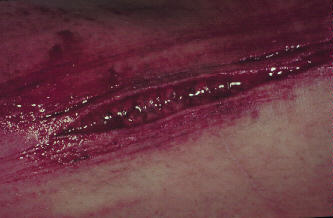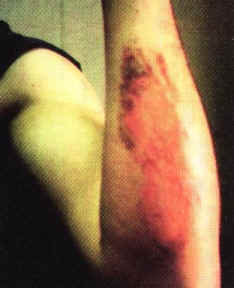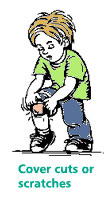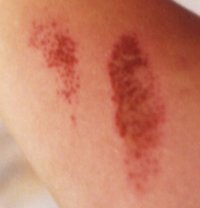




CUTS, SCRATCHES, and ABRASIONS
 |
 |
 |
 |
 |
Introduction
The glass slips from your hands and breaks when it hits the floor. You take off to find your mom and you step on a sliver of glass. Ouch! And now you're bleeding, too. Cuts, scratches, and abrasions are a part of life.
Cuts: These are injuries to the skin caused by something sharp, like a knife.
Scratches: These are slight injuries that happen when a sharp object, like a fingernail or thorn, scrapes along your skin the way a pencil scrapes across paper.
Abrasions: This is a scrape that happens when the skin is rubbed away. For example, you might get a "rug burn" while wrestling with your brother or a "board burn" if you wipe out on your skateboard when you weren't wearing kneepads.
When do cuts need stitches?
Minor cuts should stop bleeding with a little direct pressure. However, if a cut continues to bleed after 10 to 15 minutes of direct pressure, call your doctor or visit an emergency room. A cut may also need stiches if it is:
For best results, cuts usually need to be stitched within eight hours.
How Do Cuts and Scratches Heal?
After getting a cut, scratch, or abrasion, your skin may start bleeding. This happens because the injury breaks or tears the tiny blood vessels that live right under the skin's surface. Your body wants to stop the bleeding so the platelets in your blood come to the rescue.
At the site of a wound, which is another word for injury, platelets stick together, like glue. This is called clotting, which works like a plug to keep blood and other fluids from leaking out. A scab, a hardened and dried clot, forms a crust over the wound. This protects the area so the cells underneath can have time to heal.
Underneath the scab, new skin cells multiply to repair the wound. Damaged blood vessels are repaired, and infection-fighting white blood cells attack any germs that may have gotten into the wound. You can't see it under the scab, but a new layer of skin is forming. And when the new skin is ready, the scab falls off.
A scab usually falls off within a week or 2. If you pick at a scab, the new skin underneath can be ripped and the wound will take longer to heal and may leave a scar. So try not to pick at scabs.
What Should I Do if I Get a Cut or Scratch?
Stop any bleeding by pressing a clean, soft cloth against the wound. If the wound isn't very bad, the bleeding should stop in a few minutes. Then you'll want to clean the wound, using warm water and a gentle soap.
You might want to get your mom, dad, or another adult to help you get cleaned up, especially if the water doesn't get all the dirt or gravel out of the wound. A soft, damp cloth can help remove these bits.
Most small cuts, scrapes, or abrasions will heal well without any special care. For extra protection, your mom or dad might use an antibacterial ointment or a bandage. Antibacterial ointment will kill germs. A bandage will keep your wound from getting irritated and will prevent germs from getting inside. If you use a bandage, it should be changed daily and when it gets wet or dirty.
What if I Get a Cut That Won't Stop Bleeding?
If a wound is very long or deep or if its edges are far apart, then you may need stitches. The doctor will use some type of anesthetic on your skin to numb it (numb means you won't be able to feel anything there for a while). This numbing medicine might be applied directly or through a shot.
Then the doctor will suture, or sew, the edges of the cut together with a small needle and special thread.
For more minor cuts, the doctor might use a special kind of glue, instead of stitches, to close your cut. This glue holds the sides of the cut together so the skin can begin to heal. The glue will dissolve over time.
If you get stitches, after the wound heals, you will need to go back to the doctor in about a week to get those stitches taken out. The doctor will just snip the thread with scissors and gently pull out the threads. It feels funny but usually doesn't hurt.
Sometimes, a small scar forms after stitches are removed. If you don't get the proper care for a serious cut, a more noticeable scar may form.
When Should I Get Help From an Adult?
It's a good idea to tell an adult if you get injured. You'll especially want to tell a parent or another adult if you cut yourself on something dirty, rusty, or if you get bitten or scratched (by an animal or a person!).
Bites and scratches may need special care because germs from the animal or person might have gotten into the wound. The doctor might prescribe an antibiotic medicine to prevent infection. And if you were bitten or scratched by an animal, your mom or dad will need to make sure the animal didn't have rabies, a dangerous virus.
Certain cuts or bites could develop into tetanus, another serious illness. Your parent will need to check your medical records and be sure that you have had a tetanus shot recently.
Sometimes, a cut, scratch, or abrasion starts out as no big deal, but then gets infected. An infection happens when there are too many germs for your body's white blood cells to handle. Infected wounds may hurt, look red and swollen, and contain pus, a yellowish or greenish thick liquid. If your cut, scratch, or abrasion looks infected, you should talk to your parent. You may need to see a doctor for antibiotics to get rid of the infection.
But more often, your cuts, scratches, and abrasions go away on their own, thanks to your body's amazing ability to heal itself.
Disclaimer: This information is not intended be a substitute for professional medical advice. It is provided for educational purposes only. You assume full responsibility for how you choose to use this information.
Updated and reviewed by: Elana Pearl Ben-Joseph, MD Date reviewed: August 2004 Originally reviewed by: Kathleen M. Cronan, MD, and Steven Dowshen, MD
Excerpted from kidshealth.org
Sources: Group Health Cooperative, Seattle, WA; American Academy of Family Physicians; Hope Health, Kalamazoo, MI